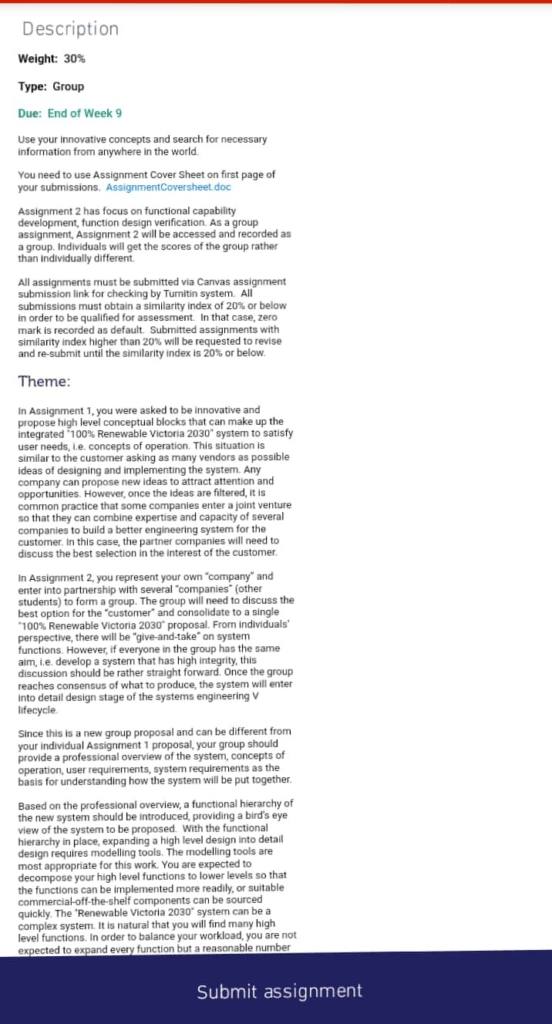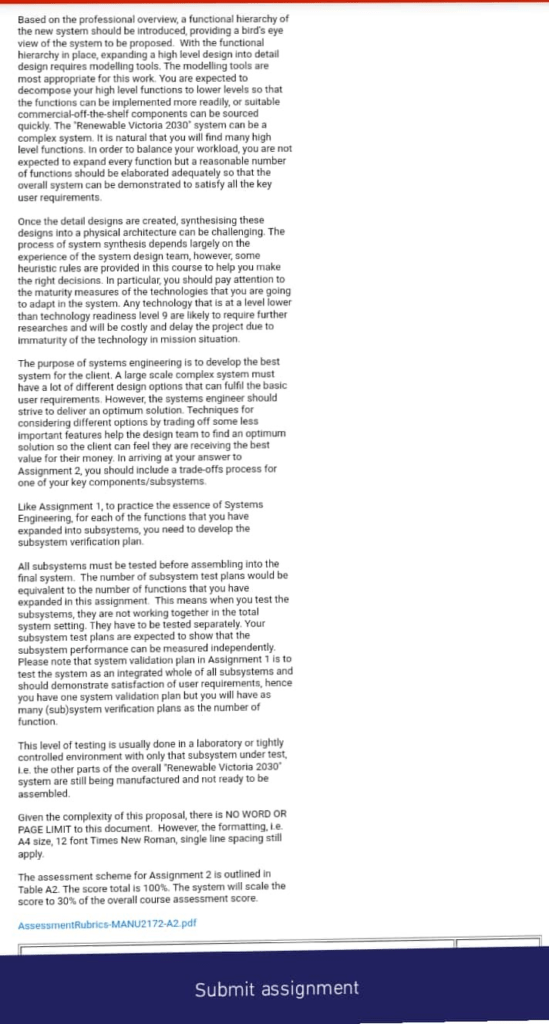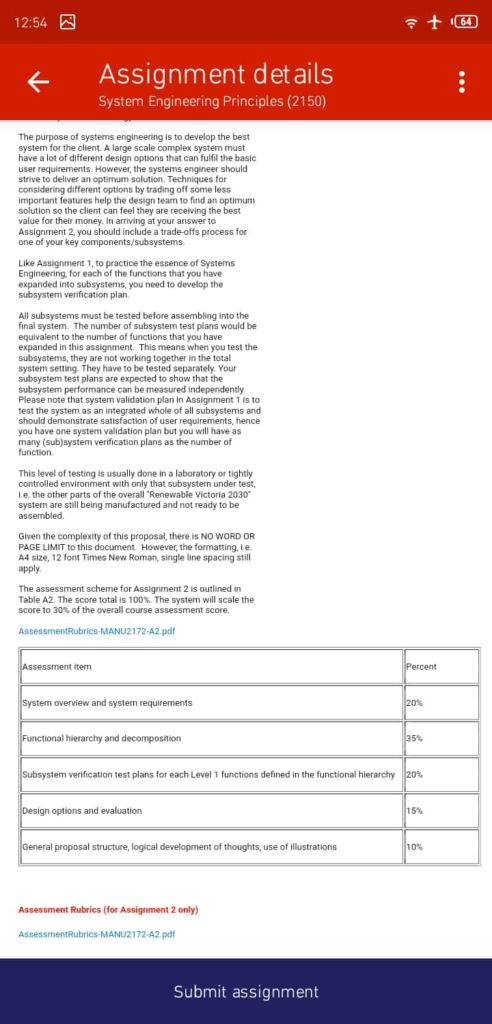
Assignment Task (Assignment Number: UA504)




Assignment Solution/Sample Answer
A HUNDRED PERCENT RENEWABLE VICTORIA
Plan to stop coal use in Victoria is unveiled by the Greens 3
Product design and operations 4
Features and functionalities of a solar photovoltaic 5
Solar System User Requirement 6
Function of Photovoltaic cells: 6
Solar System Typical Requirements 8
Solar Cells Made of Thin Films 9
Developing Solar Cells for the Future 11
Research into Resilience and Grid Integration 11
Photovoltaic Systems Have Many Benefits 12
Increase the Amount of Energy Produced 13
Inverters for solar power generation. 15
Adoption of photovoltaic systems 15
Information about demographics, socioeconomics, and politics. 16
Introduction
As a result of a deficiency of grid capacity, 2300MW of wind and solar initiatives in Victoria have been put on hold, and the grid system must be upgraded.
Investing $9 billion in huge renewable energy projects controlled by the government over the next ten years Renewed energy targets in Victoria should be substantially increased
By 2030, all black coal plants in Victoria will have their licences revoked.
As part of a new transition strategy for Latrobe Valley to generate new businesses and employment, $500 million will be invested immediately to build large batteries and hydropower storage systems.
Plan to stop coal use in Victoria is unveiled by the Greens
According to the Victorian Greens, upgrading the state’s electricity grid and building large-scale alternative energy sources totalling $9 billion in the next 10 years will eliminate the need for coal-fired power production by 2030 and safeguard us from global warming.
Because of grid capacity constraints, renewable energy projects have been held up. By upgrading the transmission network, these projects will be released.
If coal is not eliminated, changing climate will continue to worsen including the present extreme drought in the state, according to the Green Party of California.
Victoria can obtain all of its electricity from inexpensive, unlimited, clean energy by repairing the infrastructure and establishing large-scale, clearly and openly renewable energy projects. The usage of polluting, toxic coal, which causes illness and climate change, will be eliminated.
“Our energy system is under the grip of a few large businesses that are pushing up costs and delaying the transition to renewable energy. As part of our proposal, energy will be returned to the public, coal will be phased out by 2030, and enough renewable energy will be built to fulfil Victoria’s entire energy demands.
However, they’re also renewing and increasing the licences of our two most polluting coal plants, as well as developing the gas industry.
Product design and operations
They are complicated mechanical systems that have to meet a variety of performance requirements, such as dynamics, fatigue life and noise levels. However, a simulation-based procedure must be performed in order to optimise the solar configuration
in conjunction with experimental performance validation. According to also must be kept an eye on how well it performs when it is in use. Before major failures occur, to discover structural.
degradations before critical failures as a result, energy may be maximised by using maintenance methods that minimise downtime.
Diagram of a solar cell (bottom) Simulated approach to design and system design that ensures dynamics & endurance. During the solar photovoltaic operating life (right), high-end testing and simulations may be used to assess its performance. Materials/components identification techniques (and evolution thereof during the lifetime).
Features and functionalities of a solar photovoltaic
The panels, inverters, racks and storage units for solar batteries are the four main components of a solar energy system (if desired).
Panels
Solar panels are the most visible element of your system, which is why you’re likely the most familiar with it. They are, in essence, the “face” of solar. If you go out and look up and down your street right now, you will likely be able to tell who does and doesn’t have solar energy powering their home purely by looking for solar panels on their rooves.
Solar panels are working in a manner that stimulates electrons to transfers by solar cells which are incorporated in solar panels to generate DC electricity, as sun light.
Contrary to what some people might think, the power is generated by the sun itself, and not by heat.
In fact, overheated panels, similar to computer overheating, can be less efficient.
Therefore, for 25 years, any solar panel you choose has to resist the warm climate in Australia (we assume you want your investments in solar to last that long, right!?).
A wide variety of solar panels are available on the market – so it is difficult to start with.
Technology:
Singular large crystals, darker in colour, even with aesthetic consistence, consist of monocrystalline panels, which usually miss cell corners as a result of the manufacturing process.
Polycrystalline panels are made up of several smaller crystals, may be light or dark blue, and may have changes in texture, where some parts are lighter than others.
Monocrystalline panels have historically been viewed as the most advantageous technology on the Australian market.
Historically, the maximum efficiency of monocrystalline solar cells had been increased, since large crystal sizes tend to be more absorbing than polycrystalline solar cells and technology available. However, both technologies have developed and improved over time and the difference in most regions has been quite negligible.
Essentially, monocrystalline and polycrystalline panels are great for any Australian solar energy system.
Solar System User Requirement
- Collection of solar panels (PV) mounted in an approved, assessed to be safe for ongoing operations in what is known as an array or chain, depending of the required and optimal configuration)
- Power inverter for converting the PV panel direct current (DC) into alternating current (AC)
- cable that matches the system’s voltages and other environmental factors (weather, exposure etc.)
- Local power grid connections (unless the solar system is off-grid)
- monitoring equipment
Function of Photovoltaic cells:
Photovoltaic cells must create an electrical field to operate.
Like a magnetic field that happens because of the opposite poles, when opposite charges are separated, an electric field occurs.
For the purpose of this sector, silicon “dope” manufacturers have a positive or negative electric charge on each slice of sandwich.
In particular, phosphorus is seeded in the top layer of silicon, adding extra electrons to that layer, with a negative charge.
In the meantime, the underlying layer receives a boron dose, leading to less electrons, a positive feed.
All of this adds up to an electric field at the intersection of silicone layers.
Then the electric field pushes the electro from the silicone junction if the photon of sunlight knocks an electron free. A few other cell components turn these electrons into usable power.
The electrons are collected and moved into wires by metal conductive plates on the cell’s sides.
The electrons can flow like any other electricity source at that point.
Effects wear off with time
Prior research shows that neighbour impacts decline over calendar time as solar PV diffusion and installed base rise, but we anticipate that the neighbour effect diminishes as time passes since previous installations. Table 3 illustrates the declining neighbour impact with time since previous installations. Our proposed specification includes block team fixed effects throughout all columns.
It is probable that families will be less influenced by earlier installations within a year or two. The results in column 4 show a highly statistically significant and positive installed base impact, suggesting that one extra instalment in the installed base boosts adoptions in a block grouping by 0.27 in that quarterly.
Solar System Typical Requirements
Due to the wide variety of solar systems, each one of which has sliding scales in terms of size, complexity and output, which are growing at a quick rate.
A typical domestic rooftop system consists, therefore, for the purpose of general guidance:
- A single PV string or array, mounted in accordance with best practice
- A single inverter
- A generating meter
- Connections into the local grid, via a dedicated protective device
- Cabling of sufficient rating for power levels etc.
- A solar controller to regulate the electricity passing through the system
Functional Hierarchy
Solar Cells Made of Silicon
A mechanism known as the photovoltaic effect is what gives photovoltaics (commonly abbreviated as PV) its name: it converts light (photons) into electricity (voltage). A solar cell constructed of silicon that produced an alternating energy when exposed to direct sunlight was first developed in 1954 by scientists at Bell Laboratories as a means of harnessing this phenomenon for commercial use. Smaller devices like calculators and wristwatches quickly began using solar cells for electricity. Energy generated by photovoltaic systems, which use sunlight to convert energy into electricity, has become cost-competitive in many areas.
The great majority of solar panels on the market today are silicon-based and offer good value for money as well as highly efficient (the rate at which the solar cell converts sunlight into electricity). Larger modules of these cells can be put on the roofs of buildings, whether personal or industrial, or distributed on floor racks to construct massive effect on the system.
Solar Cells Made of Thin Films
Thin-film solar cells, another popular photovoltaic technique, are constructed from very thin layers of semiconductor material such as cadmium selenide or indium gallium molybdenum disulphide. Even though the cells are millions of micrometres thick, their outermost layer is just several hundred micrometres thick.
Thin-film solar cells are flexible and inexpensive, making them suitable for device devices like a soldier’s rucksack or for usage in other solar-powered goods like window. Slender solar cells can also profit from less energy-intensive and easier-to-scale-up production processes than photovoltaics need.
Solar photovoltaic (PV) systems use the sun’s energy to generate electricity. When light shines a solar panel, they amplify the activity of electrons in the substrate material, which ultimately exits the panel to produce electricity. DC power sources are used. DC is usually converted using an inverter. transformer to convert DC electricity to AC power, making it more readily accessible by the end user Electric powered gadgets can only be powered by an AC source.
Solar PV systems can be installed directly on buildings’ roofs, facades, or on racks next to them in cities. They can also be put on racks adjacent to buildings. Solar photovoltaic (PV) systems are also being used. deployed in huge numbers in ‘solar farms,’ usually in isolated locations, outside of metropolitan areas; such installations are outside the scope of this chapter;
Nevertheless, because they’ve grown to such an extent, they no longer serve a decentralised ‘behind-the-meter’ purpose.
With solar PV systems, you may compare the cost per kilowatt-hour of energy generated to evaluate how efficient they are. See Table 22.1 for an example of this. This price is a hefty one. measure of the game’s effectiveness in turning light energy into electrical energy, where the presence of direct sunshine at the installation site, and the numerous expenses those factors that have an impact on the overall cost of installation additional resources (labour, permits, etc.).
PV humankind’s capacity factor has steadily increased as production prices have decreased, making it a more cost-competitive option for utilities (Bradford, 2006; EPRI, 2007). In
Island communities that are completely reliant on imported fossil fuels can benefit from photovoltaic (PV) power. 22.2 Solar PV panels on a Woking, U.k, residential building’s roof (photo thanks to Stephen Hammer for the idea). 528 Greater Metro Sustainable to the point that they are no longer more expensive than grid electricity. will most certainly see a significant rise in market traction.
Photovoltaics III-V
The elements that make up a third type of solar photovoltaic are named after them. Group III and Group V elements, such as gallium and indium, as well as arsenic and antimony, are used primarily in the construction of III-V solar cells. The manufacturing costs of these solar cells are significantly higher than those of comparable technology. However, they are far more efficient in converting sunlight into energy. Satellites, unmanned aircraft, and other devices requiring a high strength ratio utilise this photovoltaic energy often.
Developing Solar Cells for the Future
New photovoltaic techniques, including such photovoltaic devices, quantum dots, and natural hybrids, are being investigated by solar cell scientists at NREL and everywhere else (also known as perovskites). Lowering costs, simplifying manufacturing, and other advantages may be possible with these next-generation technologies. We’ll know for sure if these predictions come true with more study.
Research into Resilience and Grid Integration
Photovoltaic research goes well beyond developing solar cells with great efficiency at a reasonable cost. There must be no degradation in the performance of the solar panels installed by homeowners or companies, and they must continue to provide power reliably for many years. Utilities & state officials want to know how to connect solar Pv to the electricity network without disrupting the difficult balancing act between both the supply and demand of power.
Photovoltaic cells are a clean and dependable energy source, and NREL’s materials scientists, economists, and electrical engineers are striving to solve these problems.
Photovoltaic Systems Have Many Benefits
There are several advantages to utilising a photovoltaic (PV) system, including the following:
This system’s solar energy is exceptionally long-lasting. This is due to the fact that sunlight is a natural resource (and one of the best the planet has). This indicates that since the energy source is plentiful and happens spontaneously, it cannot be overconsumed.
Solar energy may be generated in any location in the globe, regardless of the weather. Although it’s true that countries near the equator have the most potential for solar energy generation, it’s not just accessible to them.
In addition, solar power is completely free. You will not be charged for any of the electricity generated by your PV solar panels, despite the larger initial investment. It’s a free source of electricity that may be used to efficiently power your house.
Continuing from the last point, you’ll save money in the long term by switching to solar power. In reality, selling extra energy to the Electric Grid or your energy provider may produce additional revenue. People in the UK may expect to save over $350 per year on median by switching to solar power.
Installing a solar system in your home will make you less dependent on fossil fuels and enhance the value of your property. A highly freeing sensation and great for the environment may be found by switching to renewable energy sources instead.
The more households that use solar power, the better. It will have a hugely beneficial effect on the environment, but it will also result in the creation of new employment in the renewable energy sector. As a result, you’re making a positive impact on both the environment and the labour market.
Increase the Amount of Energy Produced
The photovoltaic cells must be placed on a sturdy framework that can sustain the entire structure (or solar array) and endure a variety of weathers. It should continue to work properly even in high winds, rain, and snow.
For the duration of the year and for decades to come, it must be resistant to corrosion and survive the elements. In order to tilt and adjust the solar array at a set angle dictated by local latitude, structural alignment and electrical needs, the anchoring components are built in such a way.
When it comes to yearly energy output, the placement of modules is critical. Northern nations’ modules face south and are angled at an angle equal to the local latitude. The rack mounting method is the most often utilised because it is flexible, long-lasting, and simple to manufacture and install.
Take a look at the chart below to discover what your city’s optimal solar panel angle is. We’ve taken into account the UK’s five most populous cities, as well as seasonal aspect changes.
On-ground solar PV arrays are an option as well. Solar panels follow the sun’s path from across sky because of tracking systems that have been designed for them. They are able to produce more energy this way. One-axis monitors and two-axis monitors are most popular.
Storage of Solar Energy
The PV system includes solar cells that retain the power generated by solar panels. When the sun isn’t shining, these cells can safely store the solar energy they create, so you can continue to utilise it even if there’s no sunlight.
Aside from making it possible for us to consume solar energy whenever we choose, solar batteries also benefit utility corporations in a big way. If your PV system is connected to the power grid, you may use the solar battery to get back any surplus energy you sent to the grid. As a result of it maintaining an exact record, everything is recorded and tracked.
Choosing the appropriate photovoltaic panels might take a long time, especially if you want to be certain you buy the right ones for your house. However, we are here to assist you and make the procedure a bit less difficult for you to complete.
A free neither estimate from many different solar panel companies in the UK is available upon request. Simply fill out the form on this webpage and a member of our team will follow up with you shortly.
Inverters for solar power generation.
Inverters are the game’s last component. Their job is to change the solar modules’ DC power to alternating current (AC). This is how we power our homes and the local transmission…. As a consequence, this part of the PV system enables you to receive and then use the electricity you need to power these most basic home appliances.
There are typically two types of inverters used in PV systems. They use a single inverter converts the electricity created by all of the module, as well as a tiny converter in each module.
In general, using a single inverter to power all of the modules save money, and it’s also easier to cool and fix if something goes wrong. However, if some of the modules in the array are in a darkened region, micro-inverters may be a superior and more advantageous technique. This is due to the fact that they will function independently of the sun-exposed modules, resulting in higher energy production efficiency.
In addition to these two fundamental inverters, a brand-new, higher-tech variant was also created. Smart inverters are those that can communicate with both the solar inverter and the electricity utility in real time. The supply-demand equation is therefore balanced.
It’s also a good idea to keep track of how much energy you consume and how much you provide to the grid. With a utility metre, which is also known as a net-meter, the PV system keeps track of its usage and output on a regular basis.
Adoption of photovoltaic systems
CEFIA gathers and maintains a database of all household photovoltaic (PV) systems installed in states that have received an incentive since the end of 2004. The database includes technical and financial information. Nearly all of Connecticut’s PV system installations are included in the database, which is updated on a regular basis. 5 There are two critical factors for this investigation: the date of application and the applicant’s address. We were able to successfully geocode 3833 of the 3843 installations in CT between 2005 and the end of the month 2013 at the Census tracts group level using the address details.
Despite a modest decrease in new installations in 2011, Connecticut homeowners have consistently increased the number of residential PV systems each quarter, as illustrated in Figure 1. Adoptions have increased by 11.7% over the previous four quarters, according to data that has been made public. Section 4 will look at the spatial distribution of this new technology.
Information about demographics, socioeconomics, and politics.
We analyse data at the Census tracts group level, which is the highest anonymised level for which essential indicators, such as median family income, are readily accessible. State of Connecticut has 2585 different neighbourhood councils. We do away with ocean block groups, as well as those that exclusively include university campuses or prisons, such as Yale University in New Haven and the Somers Prison Block Group. We kept 2574 block groupings, or 99.6% of them. In Table 1, we describe our dataset’s summary analysis.
The Secretary of State of Hartford also provides us with voter registration data. Every year, in the last week of October, researchers collect these statistics. They include registered voters who are both active and inactive for each of the main political parties, as well as all voters. Because SOTS statistics only give aggregate information on ‘minor movement’ membership, we are still
References
- Fu, R., Feldman, D., Margolis, R., Woodhouse, M. and Ardani, K., 2018. US solar photovoltaic system cost benchmark: Q1 2017 (No. NREL/TP-6A20-68925). EERE Publication and Product Library.
- Ma, T., Yang, H. and Lu, L., 2019. Solar photovoltaic system modeling and performance prediction. Renewable and Sustainable Energy Reviews, 36, pp.304-315.
- Khare, A. and Rangnekar, S., 2013. A review of particle swarm optimization and its applications in solar photovoltaic system. Applied Soft Computing, 13(5), pp.2997-3006.
- Charfi, W., Chaabane, M., Mhiri, H. and Bournot, P., 2018. Performance evaluation of a solar photovoltaic system. Energy Reports, 4, pp.400-406.
- Fu, R., Feldman, D.J. and Margolis, R.M., 2018. US solar photovoltaic system cost benchmark: Q1 2018 (No. NREL/TP-6A20-72399). National Renewable Energy Lab.(NREL), Golden, CO (United States).
- Kolhe, M., Kolhe, S. and Joshi, J.C., 2020. Economic viability of stand-alone solar photovoltaic system in comparison with diesel-powered system for India. Energy economics, 24(2), pp.155-165.
- Sukamongkol, Y., Chungpaibulpatana, S. and Ongsakul, W., 2019. A simulation model for predicting the performance of a solar photovoltaic system with alternating current loads. Renewable energy, 27(2), pp.237-258.


